“Items may shift during flight…”
…and may cause a (minor) medical emergency.
I recently had my first medical diversion ever.
It was the first flight of a three-day trip, JFK to LAX, and the weather was good all the way across the country. About 300 miles east of Denver, we got a call from the lead flight attendant. A passenger had opened an overhead bin to retrieve her bag and another bag fell out onto the top of a 56 year-old gentleman’s head. The flight attendant told us that the man said he was fine, but she thought we should know. I thought that would be the end of it.
Twenty minutes later, the flight attendant called again. The man now complained of pains radiating from his head down through his neck and shoulders. The Captain asked her to get all the pertinent information to us (we have a form for that) then to see if there’s a doctor on board (there frequently is). We then initiated a call over the radio to our on-call medical resource, called STAT-MD, which lets us talk to a doctor for advice on handling the situation.
While we were doing that, the flight attendants did find a doctor on board, who discovered that the “patient” was taking a medication called coumadin, a blood thinner. This increased the doctor’s concern with the symptoms, and when we relayed that bit of information to the doctor at STAT-MD, he advised us to get this passenger on the ground immediately for further diagnosis. At this point, we were about 100 miles east of Denver so we started down from Flight Level 380 (38,000 feet).
The passenger didn’t want to divert, but it wasn’t his call. I suppose we can all imagine the kind of liability issues that could arise if we elected to skip the diversion and the man’s condition became critical during the last 90 minutes of flight to L.A.
We were pretty busy during the descent, getting out the approach charts for Denver, briefing the approach, calling Denver Operations to get a gate assignment, and running checklists for the descent and approach. Normally one of us would make a PA to the passengers, but we were so busy that we had to delegate that to the lead flight attendant. Declaring a medical emergency really gets you some expeditious handling by Air Traffic Control, and we got cleared straight in to the airport and got taxi clearance right to the gate, with other planes holding for us.
The passenger/patient was met by medical personnel, who escorted him off the plane. Then we got some fuel and a new dispatch release to continue our flight. We were on the ground for 40 minutes. As we continued on our way to Los Angeles, I wondered just how much of an inconvenience this would end up being for that passenger. There was a good chance he wouldn’t make it to L.A. until the next day, but we’d never know the rest of the story.
/https://tf-cmsv2-smithsonianmag-media.s3.amazonaws.com/accounts/headshot/Steve-Satre-headshot.jpg)

/https://tf-cmsv2-smithsonianmag-media.s3.amazonaws.com/accounts/headshot/Steve-Satre-headshot.jpg)